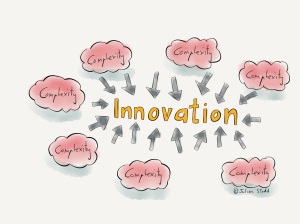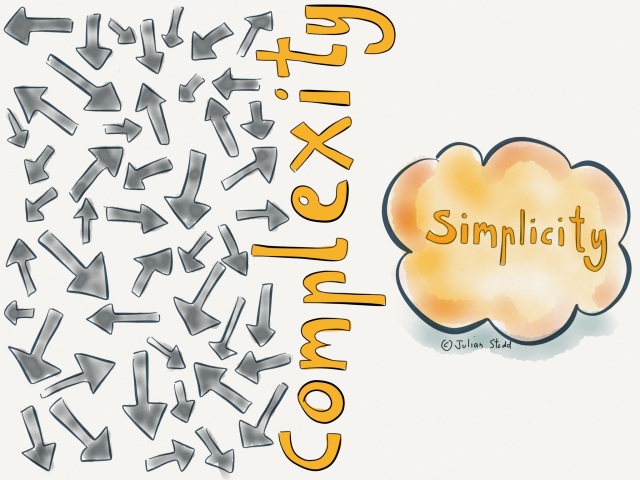Agility comes through fluidity: an ability to adapt to circumstance, to diagnose, to deploy, to learn. In essence, it’s simple: codify enough into process to give replicability and scale, keep enough freedom to adapt, to change course as circumstance demands. In practice, it’s often harder. Today, in a more reflective piece, i want to explore why: why complexity confounds organisations and how simplicity can only be found once we reach the other side.
Let’s start with the ground rules: the complexity and constant change of the Social Age cannot be countered by brute force alone. No organisation can take a rules based, reactive approach and hope to thrive. Why? Because the ecosystem has changed, the competition is asymmetric and the change constant. Social authority and amplification, the democratisation of technology and the rise of collaborative community subverts formal process and authority. So the responses, resources, and strategies required to survive need to change too. Agility can’t come through process, resource or systems alone: it has to be based in mindset.
Simplicity is the goal, but the path we take to get there may be complex. The organisation needs to learn to understand complexity and counter it with simplicity. Not creating rules, but rather creating spaces and permissions for problem solving. Read that carefully: learn complexity and counter it with simplicity.
Most organisations try to contain complexity with ever more complex rules. A cage of complexity.
This is at the core of agility: instead of trying to have the answer to everything, have the ability to find the answer fast. And then find a different answer tomorrow, in a different way. When it works, it’s simple: an entity able to adapt and respond to environmental pressures in a seemingly effortless way, because the agility is coded into it’s DNA. Responsive by design.
When it doesn’t work, the organisation may be able to adapt to circumstance, but at great energy and cost. It’s the difference between technique and brute force. A computer can crack any code by brute force alone, by trying every possible combination, but it’s not efficient. We are aiming for efficiency.
Take my flight back from New York last week: as the plane was cancelled, i had to get booked onto a new flight. But i got caught in a loop between British Airways, who i had booked with, and United Airlines, who owned the plane i was moved onto. The result was that i spent three hours on the phone trying to get it resolved: at every stage, the systems, scripts, responses and replies added complexity, largely generated by the inflexibility of a system designed to respond to ‘normal‘, not respond to change. Complexity kills agility.
Nobody had permission to resolve it. Several people empathised, which is nice, but utterly ineffective. When the person on the phone says “i can understand the problem, i can understand the solution, but i cannot enact it” you know that you lack agility. Lethargy codified into process and system.
At one level, you can read this as just poor customer service, but it goes much much deeper than that: it’s about how fit you are to compete, how likely you are to survive.
Complexity kills Innovation. Complexity will kill your business if you are unable to adapt.
So what are the tools for mastering complexity? I’d suggest the places to start are with narrative and community. Traditionally the knowledge has resided in tribes, in groups who informally subvert process in the name of efficiency, but do it in hidden ways. As an organisation, being able to tap into this community, to use it’s ‘sense making‘ capability and somehow formalise it is key.
 I heard a nice story the other day, a military recruit who came out of a training session: his future squad leader put his hand on his shoulder and said “that was nice, but this is what we’ll actually do in the field so as not to get us both killed“. The convergence of codified knowledge and experience, leading to agility. In the first world war, both sides kept going over the top and running into the machine gun bullets because they lacked agility in thinking or action, they lacked permission to even question ‘why?‘.
I heard a nice story the other day, a military recruit who came out of a training session: his future squad leader put his hand on his shoulder and said “that was nice, but this is what we’ll actually do in the field so as not to get us both killed“. The convergence of codified knowledge and experience, leading to agility. In the first world war, both sides kept going over the top and running into the machine gun bullets because they lacked agility in thinking or action, they lacked permission to even question ‘why?‘.
Our starting point has to be finding ways to hear the organisational narrative, ways to hear where the complexity lies, but not with a view to capturing and killing it, rather with a view to understanding how the tribes currently circumnavigate it.
Remember: complexity breeds complexity. Rule based approaches to agility will fail because they are subverted by further complexity. This is why most social media policies fail: because they attempt to patch up every hole, rather than providing spaces and permissions to operate within The same with regulation for banks: it may tell us what’s wrong, but it surely doesn’t tell us what’s right.
I’ve looked at this before, thinking about ‘fairness‘. Many organisations tell us what is unfair, discriminatory, biased, but fail to help us find fairness within that frame. Complexity creates a cage, but it doesn’t give us agility.
At a simple level, it’s about providing spaces for experimentation and rehearsal. It’s about providing mechanisms for the three levels of narrative: personal, co-created (community) and organisational. What do we learn as individuals, how do we reflect on that and take it into community. As community, how do we ‘sense make‘ these multiple individual narratives, and as an organisation, how do we respond to the personal and community stories. That’s the route to simplicity.



Reblogged this on juandon. Innovación y conocimiento.
ok…!!!
Do you see a difference between complication & complexity? Your airline experience strikes me as series of complications, not a complex problem.
I didn’t, but i do now… i think you’re right. Perhaps this: my problem was one of complications. But i think the organisation has engineered complexity into systems and processes: there is no straight line to resolution because the wheels are locked into the rails.
The notion i’m reflecting on (and it’s early days of refelction) is that we have to go through compexity to find simplicity, but that organisations often get stuck at complex. They frame it and cage it, but don’t get past it. What i need to think on is the difference between complex and complication. I guess even simplicity can involve complication…?!
Thanks Harold, as ever, valuable reflections, Julian
Pingback: Uncommonly Global | Julian Stodd's Learning Blog
Pingback: To Simple, Through Complexity | Elearning, lea...
Pingback: To Simple, Through Complexity | Workplace Learn...
Julian, I find this useful to use as a framework for progressing consideration of digital pedagogy as part of the learning design process. I am refering to the final paragraph in your blog post. Do you have a visual for this?
I expand on the three levels of narrative here: https://julianstodd.wordpress.com/2015/02/05/storytelling-through-change/
Thanks for visiting 🙂
I am vvery happy that I have discovered your thinking and visuals
Thank you 🙂 I’m very happy to welcome you to the community here!
Pingback: This Week’s Links « Timothy Siburg
Pingback: mLearnCon & Performance Support Symposium Refections Day 2: Progress | Julian Stodd's Learning Blog
Pingback: 16 Resisters of Change | Julian Stodd's Learning Blog
Pingback: A State Of Radical Complexity | Julian Stodd's Learning Blog
Pingback: Apollo | Julian Stodd's Learning Blog